Benchmarks, Conclusion
Test Setup:

Being unable to secure a 4GB DDR3 kit in time for testing left the system with “old” DDR2, which, on AMD platforms, lags behind about DDR3 by about approximately 5 to 10 percent, depending on the workload. This should be rectified in time for future reviews. To make this review as accessible as possible, two well-known screen resolutions were chosen: “720p” (1280x720) and “1080p” (1920x1080).
Far Cry 2
This Ubisoft title has been a staple of GPU reviews for some time now, for a few reasons; it tends to scale quite well, helping to illustrate performance gaps between products, and it’s also still quite demanding on graphics cards.
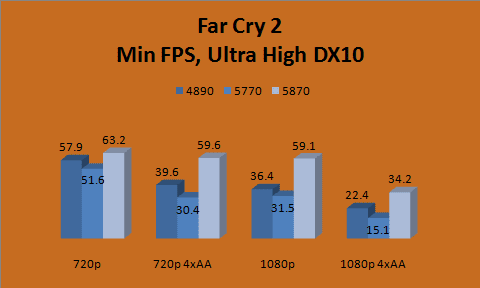 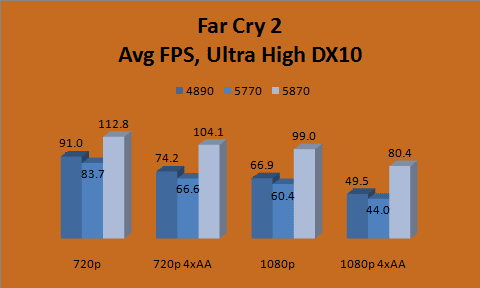
At 720p the 5870 is barely touched, as it pulls minimum frame rates above 60 frames-per-second; with average frame rates near enough to 100 to be considered pretty much flawless. This trend continues at 1080p, suggesting that the processor - hardly a slouch, with four cores at 3.4GHz - is actually holding the card back at the lower resolution. Only when anti-aliasing is enabled do we see a performance hit, though the minimum fps stays above 30, and it leads the 4890 by roughly 35%.
The 4890 averages a 20% advantage on the 5770, with respect to minimum frame rates. What’s interesting to note is that the advantage is more pronounced when anti-aliasing is enabled (up to 32%). The 50GB/s memory bandwidth imbalance in the 4890’s favour seems particularly apparent in this scenario. Average frame rates between these two near-identical cards tip in the 4890’s favour by around 10% in this game.
Stalker: Clear Sky
As the following results will attest, this game’s X-Ray 1.5 engine is capable of bringing a GPU to its knees. With image quality preset to Ultra, Enhanced full dynamic lighting and anti-aliasing, this is GPU torture.
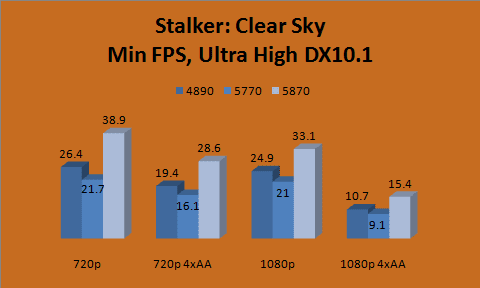 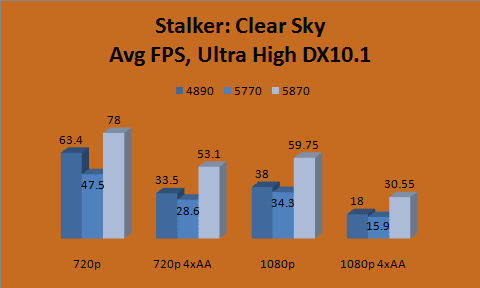
Even at the relatively low 720p resolution, only the 5870 can provide a seamless experience, with frame rates just barely dropping below 40, and averaging almost 80. Turn 4x anti-aliasing on and the card takes a hit, as expected, though you could probably still game at this setting.
At 1080p the 5870 ekes over the 30fps minimum, remaining playable for most, though this isn’t the case with 4xAA switched on. As far as percentages go, the 5870 maintains a 30% margin over the 4890. The 4890 itself distances itself a tad more from its little brother the 5770, this time leading all tests by around 15%. This would tend to suggest GSC Game World’s engine is sensitive to a card's memory bandwidth (again, it’s the main architectural difference between the 4890 and 5770). If you play this game a lot, overclock the memory on your video card as much as possible.
Crysis: Warhead
.. “yeah, but can it run Crysis”? It’s could be argued that a game is a good test of a system when an Internet meme is attributed to it. Even if The Internet is wrong (and I’m not sure that’s possible), no one can argue with the system-crippling effect that games based on Crytek’s engines have regularly handed out, ever since the original Far Cry debuted in 2004.
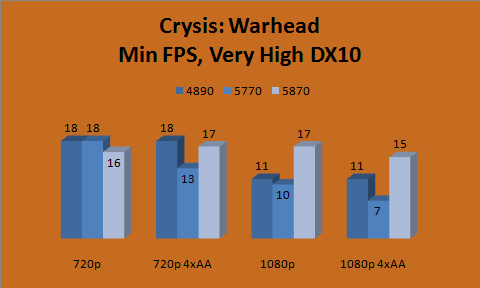 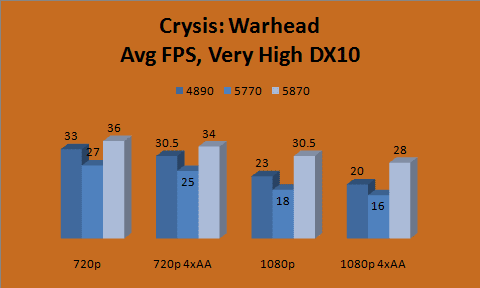
The 5870 appears to be suffering again from a lack of CPU power, as the minimum frame rates stay pretty much consistent across the two resolutions and quality settings. Furthermore, the average frame rate only drops by 25% from lowest to highest image quality, even though the amount of pixels it has to render has more than doubled, let alone the anti-aliasing on top of that.
At 720p, the 5870 loses out to its less powerful predecessors by a small margin, which I have to assume is caused by quirk of the drivers. At 1080p the 5870 again leads the 4890 by approximately 30%.
The 4890 further stretches the margin over the 5770, this time by an average of 20%. The minimum frame rate tests reveal some interesting patterns, as the 5770 basically equals the 4890, until anti-aliasing is turned on, where (again) the lack of memory bandwidth comes to the fore.
GTA IV
The latest in Rockstar Games’ powerhouse franchise broke all records for an entertainment product when it was released, to the surprise of just about no-one. On a (well-equipped) PC, the sheer scale of visual detail on offer, particularly draw distance, is quite impressive.
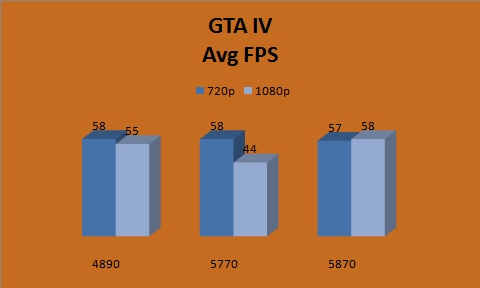
These settings were auto-adjusted for the 5870, but proved to be not much of a struggle for any of the cards. In a familiar pattern, the 5770 falls behind at 1080p, where the more expensive and well endowed cards pull ahead by 20%.
It’s not graphed here, but raising the view distance by almost 50%, from 33 to 48, also failed to dent the 5870’s benchmark result. It should be stressed that this in-game benchmark is quite short, and in general gameplay the differences are more pronounced. It’s also worth noting that the game appears to be enforcing some kind of hard 60fps limit, although V-sync was most definitely turned off.
Conclusion
There are two main points that can be drawn from the results of these tests. The first is that 5870 is at least 25% faster, across all tests, than the (already pretty quick) 4890. This solid jump comes at a fairly hefty price, as you’re currently looking at an AU$520 price tag. Thankfully, no power supply upgrades are necessary, as the TDP remains very similar to the 4890’s.

The second point is that the 4890 is around 15% faster than the 5770, although the 4890 costs approximately $40 more. Whilst this makes the 5770 quite a bargain at about AU$190, potential customers should take into account that the 5770 will struggle more at higher resolutions or with anti-aliasing enabled, due to its narrower memory bus.
With competitor Nvidia’s first DirectX11 cards apparently not far from launch, it wouldn’t be surprising to see AMD drop prices on their Radeon cards in an attempt to take the sting out of their competitor's announcements. Seems like a pretty good time to be a PC gamer with a few hundred bucks to spare!
Thanks to AMD for providing samples.
|


